

Why was a restoration necessary? Apostasy and Restoration - Dallin H. Oaks. The Church of Jesus Christ of Latter-day Saints has many beliefs in common with other Christian churches.
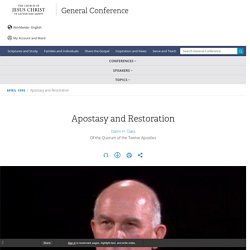
But we have differences, and those differences explain why we send missionaries to other Christians, why we build temples in addition to churches, and why our beliefs bring us such happiness and strength to deal with the challenges of life and death. I wish to speak about some of the important additions our doctrines make to the Christian faith. My subject is apostasy and restoration.
Last year searchers discovered a Roman fort and city in the Sinai close to the Suez Canal. Though once a major city, its location had been covered by desert sands and its existence had been forgotten for hundreds of years (see “Remains of Roman Fortress Emerge from Sinai Desert,” Deseret News, 6 Oct. 1994, p. We would be wiser if we could restore the knowledge of some important things that have been distorted, ignored, or forgotten.
Then came the First Vision. The Apostasy and Restoration. Apostasy, Restoration, and Lessons in Faith - Ensign Dec. 1995. Supported by scripture and the words of prophets, The Church of Jesus Christ of Latter-day Saints teaches unequivocally that there was an apostasy from the Lord’s one and only true church following the deaths of Christ’s early Apostles.
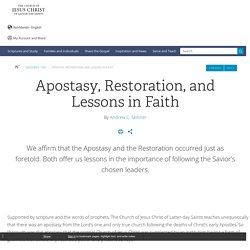
So thorough was this apostasy that the original Church of Jesus Christ was supplanted by an institution having a form of godliness but devoid of priesthood power and priesthood keys. Magna Carta. Myth and history are intertwined in the England of 800 years ago.
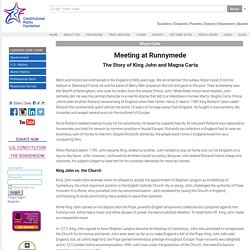
We all remember the outlaw, Robin Hood. From his hideout in Sherwood Forest, he and his band of Merry Men preyed on the rich and gave to the poor. Their archenemy was the Sheriff of Nottingham, who took his orders from the sinister Prince John. While Robin Hood never existed, John certainly did. He was the central character in a real life drama that led to a milestone in human liberty: Magna Carta. Since Richard needed revenue to pay for his adventures, he taxed his subjects heavily. When Richard died in 1199, John became King.
King John vs. the Church King John made more enemies when he refused to accept the appointment of Stephen Langton as Archbishop of Canterbury, the most important position in the English Catholic Church. While King John carried on his dispute with the Pope, powerful English landowners called barons conspired against him. King John vs. the Barons The Road to Runnymede A stalemate ensued. Aftermath 1. The Magna Carta, 1215 (translated from the Latin) Since for God, for the improvement of our kingdom, and to better allay the discord arisen between us and our barons, we have granted all these concessions, and wishing that the concessions be enjoyed in their entirety with firm endurance (for ever [5]), we give and grant to the barons the following security: Namely, that the barons choose any twenty-five barons of the kingdom they wish, who must with all their might observe and hold, and cause to be observed, the peace and liberties we have granted and confirmed to them by this our present Charter.
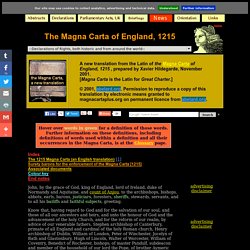
Story of the World Volume 2: The Middle Ages Book List. Seven Wonders of The Ancient World. David's work harnesses the power of spiritual symbols and sacred geometry to bring those wearing them health, happiness, vitality, abundance, and above all - love.
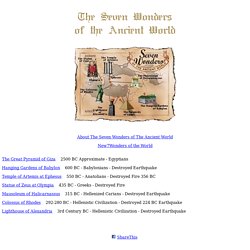
David's jewels are meticulously crafted to work on conscious and subconscious levels to inspire people's lives. David's Work is based on Sacred Geometry, Mystical Kabbalah, Astrology, Buddhism and other ancient cultures. To learn more visit Ka Gold Jewelry. Daily Life of a Nun in the Middle Ages. Interesting facts and information about life and the lives and roles of women in theMedieval period of the Middle Ages Daily Life of a Nun in the Middle AgesThe daily life of Medieval nuns in the Middle Ages were based on the three main vows: The Vow of PovertyThe Vow of ChastityThe Vow of Obedience Medieval nuns chose to renounce all worldly life and goods and spend their lives working under the strict routine and discipline of life in a Medieval Convent or Nunnery.
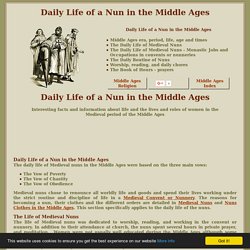
Medieval Monasteries. The cloister of Saint-Pierre, Moissac, France, built about 1100.
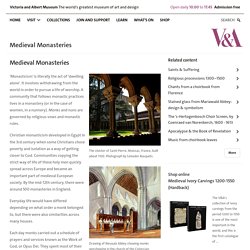
Photograph by Salvador Busquets. Drawing of Rievaulx Abbey showing monks worshipping in the church of the Cistercian monastery. © English Heritage Photo Library. 'Monasticism' is literally the act of 'dwelling alone'. It involves withdrawing from the world in order to pursue a life of worship. A community that follows monastic practices lives in a monastery (or in the case of women, in a nunnery). Christian monasticism developed in Egypt in the 3rd century when some Christians chose poverty and isolation as a way of getting closer to God. Everyday life would have differed depending on what order a monk belonged to, but there were also similarities across many houses.
Each day monks carried out a schedule of prayers and services known as the Work of God, or Opus Dei. Life in a Christian Monastery, ca. 585. Life in a Christian Monastery, ca. 585.
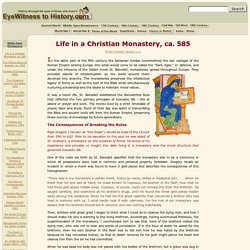
Medieval Crafts for Kids. Maps § Digital Atlas of Roman and Medieval Civilization.